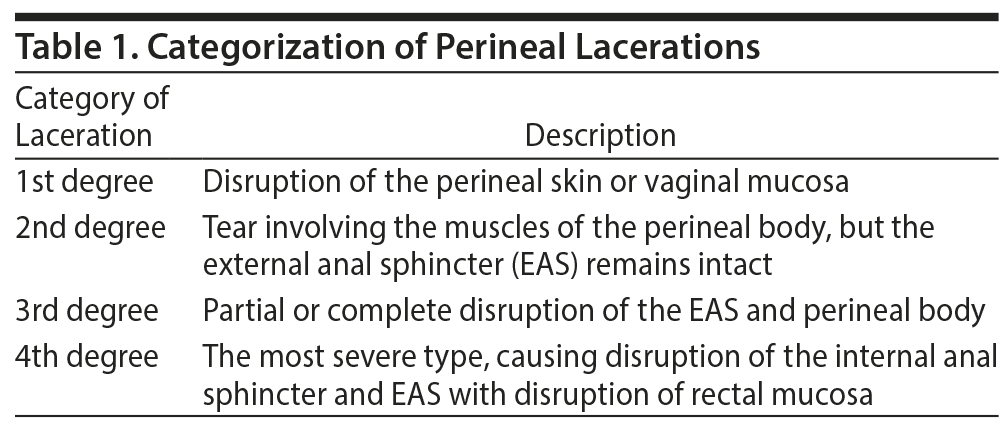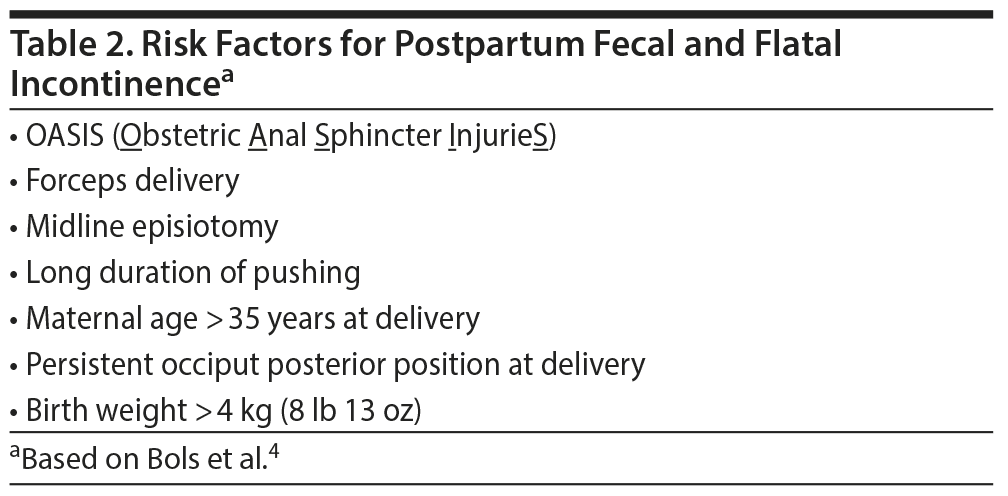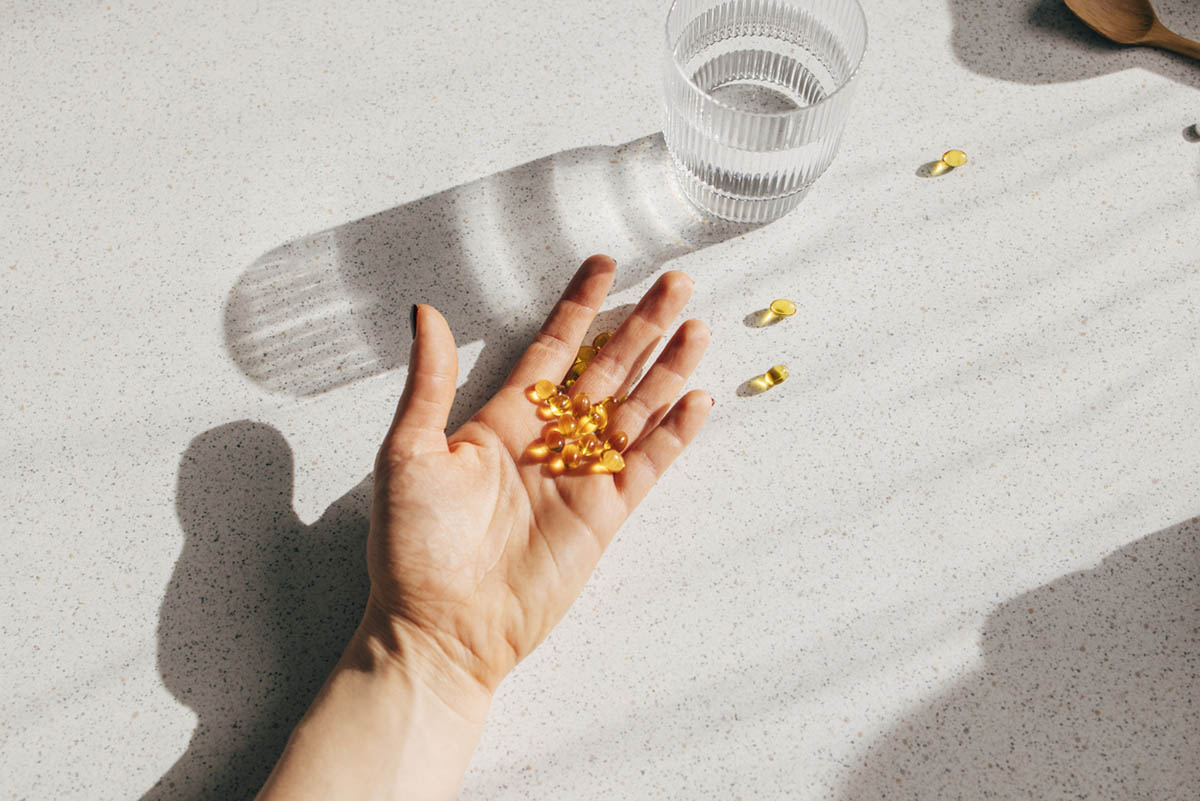Because this piece does not have an abstract, we have provided for your benefit the first 3 sentences of the full text.
Have you ever wondered how common bowel and bladder dysfunction are postpartum? Have you ever felt ill-prepared to make a decision with regard to further workup or treatment? Have you been unsure about how to manage the psychological sequelae of postpartum fecal and flatal incontinence?
Postpartum Fecal and Flatal Incontinence:
Silence, Stigma, and Psychological Interventions
Have you ever wondered how common bowel and bladder dysfunction are postpartum? Have you ever felt ill-prepared to make a decision with regard to further workup or treatment? Have you been unsure about how to manage the psychological sequelae of postpartum fecal and flatal incontinence? If you have, then the following case vignette and discussion should prove useful.
CASE VIGNETTE
Ms A, a 27-year-old woman (gravida 1, para 1), delivered a healthy baby vaginally. She presented for an annual examination 4 months postpartum. After being asked how she was doing since the delivery, she sheepishly admitted that she had been having issues with bowel control. She reported having passed flatus frequently without intending to do so and had a few episodes of staining her underwear with loose stools each month. She never had this issue before the delivery. Upon further questioning, it became clear that she had a time-consuming repair after the baby was born. The delivery documentation revealed that she had a third-degree laceration.
The bowel problems were negatively affecting Ms A’s ability to enjoy intimacy with her partner, and she wanted to know if there was anything she could do to improve the problem. Ms A also wanted to know if having another baby would make the problem worse, since she would like to have another child.
WHAT ARE FECAL AND FLATAL INCONTINENCE?
Anal incontinence is the overarching term for both fecal and flatal incontinence. Fecal incontinence is the involuntary loss of liquid or solid stool. Liquid stool loss is more common, with incontinence of solid stool indicative of more severe dysfunction. Flatal incontinence describes loss of gas only and is the most prevalent type of anal incontinence.
Anal incontinence may be caused by several mechanisms, as the mechanism of continence itself is complex. Obstetric injury has the potential to cause both neurologic and muscular damage to the pelvic floor. The internal anal sphincter (IAS) comprises smooth muscle that provides resting anal pressure, while the external anal sphincter (EAS) contracts with valsalva maneuvers and can be squeezed voluntarily. Damage to the EAS can cause urge-related or diarrhea incontinence, while dysfunction of the IAS can affect continence during rest. Pelvic floor muscular support adds a further level of support, with the puborectalis muscle acting as a sling under the rectum to maintain the anorectal angle.
The pudendal nerve innervates the majority of the pelvic floor and plays an important role in continence. It is a mixed nerve, arising from S2, S3, and S4, with the motor neurons innervating the EAS and part of the puborectalis muscle and the sensory neurons providing sensation to the perianal and genital skin. Damage to this nerve occurs with stretching during passage of the fetal head through the birth canal and is more likely to happen with a larger head, longer duration of pushing, or with forceps deliveries. If a stretch injury (segmental demyelization and no axonal damage) is sustained, function typically returns within 3 months. Injury to the sensory aspect of the pudendal nerve can diminish rectal sensation, leading to constipation and fecal overflow, while damage to motor fibers can affect the anorectal angle and inhibit the contractile function of the EAS. Long-term damage can lead to sphincter degeneration and incontinence later in life.1
WHO IS AT RISK FOR FECAL
AND FLATAL INCONTINENCE?
Some degree of anal incontinence after pregnancy is common. Women undergoing vaginal delivery are at greatest risk, with an estimated 13%–25% of women affected postpartum.2,3 Anal sphincter injury during delivery (described as a third- or fourth-degree perineal laceration) (Table 1) is the most strongly correlated risk factor for postpartum incontinence.3,4

Factors that place women at risk for anal sphincter laceration are risk factors for early and long-term anal incontinence. Median episiotomy, longer duration of pushing, fetal macrosomia (> 4,500 g), and either forceps- or vacuum-assisted delivery increase risk of EAS injury and anal incontinence.5–7 Forceps delivery has also been consistently shown to cause more trauma to the pelvic floor than a spontaneous delivery or a vacuum-assisted delivery.6 Increasing maternal age at time of delivery increases risk of EAS injury and is an independent risk factor for fecal incontinence.7 After the age of 18 years, rates of EAS injury and fecal incontinence go up with an increased odds ratio of 1.06 per year.7 Table 2 provides the risk factors for postpartum fecal and flatal incontinence.

Cesarean delivery is not completely protective. In a mixed cohort of women who had labored prior to Cesarean delivery and those who had not, fecal incontinence occurred in 7% at 6 months postpartum and in 4.5% 3–5 years after delivery.2,4,5 Theoretically, women who have not labored would have less impact to both the muscles of the pelvic floor and the nerves that supply it; however, no trials have conclusively demonstrated a substantial difference in these 2 populations. A 2010 Cochrane review8 thus does not advise Cesarean delivery for the prevention of anal incontinence.
HOW SHOULD FECAL AND FLATAL INCONTINENCE BE EVALUATED AND TREATED?
The patient’s history should be elicited to assess the frequency of accidents, description of stool patterns, preceding urgency, severity of symptoms, and precipitating events. Presence or absence of back pain should be noted. The physical examination should include inspection of the perianal area and a digital rectal examination. Perianal reflexes to assess for the presence of an anal wink will demonstrate contraction of the EAS. The EAS is innervated by the pudendal nerve and demonstrating an intact anal wink suggests at least some intact nerve innervation and anatomic integrity of the EAS.
The first-line intervention involves use of stool-bulking agents, in particular, powder-based supplementation. Fiber, such as methylcellulose, can improve stool consistency and accidental loss of both stool and gas. If diarrhea is a trigger, loperamide can be helpful in reducing urgency and stool loss. Completing a food diary helps women discover dietary triggers, which then can be avoided. Common offenders are caffeine, lactose, and fructose. Eating small meals rather than large meals can decrease the sense of urgency as well.
Physical therapy with biofeedback can be helpful in women with low EAS tone. In women who have EAS lacerations following delivery, pelvic floor muscle training within a month of delivery results in reduced rates of anal incontinence.9 Physical therapy can be conducted by trained therapists who guide patients or use vaginal biofeedback sensors to direct patients to contract the muscles of the pelvic floor. The goal is to target both fast- and slow-twitch muscle fibers and contract the genital hiatus. Patients are also counseled to avoid constipation, carrying heavy objects, and weight-bearing exercises during the early healing period.9
Few medications have been shown to be effective in treating anal incontinence. A small study10 demonstrated some efficacy in using amitriptyline, which is thought to work by decreasing the amplitude and frequency of rectal motor complexes and by slowing colonic transit, leading to firmer stools.
WHAT IS THE TYPICAL CLINICAL COURSE OF POSTPARTUM FECAL AND FLATAL INCONTINENCE?
Generally, anal incontinence symptoms will improve on their own, with studies1,9 suggesting that neuromuscular injuries sustained during pregnancy, labor, and delivery resolve within 12 months of delivery in most women. Of the interventions suggested, only pelvic floor physical therapy has shown benefit in improving these injuries. One long-term study11 with 12-year follow-up demonstrated lower rates of fecal incontinence 1 year after delivery with postpartum intervention of pelvic floor physical therapy, but there were no differences in outcomes 12 years after delivery. Improvement and long-term continence are unpredictable, although 2 predictors of long-term fecal incontinence are known: continued fecal incontinence 3 months postpartum and repeat EAS injury with subsequent delivery. Of women reporting fecal incontinence 3 months postpartum, 43% had symptoms 12 years after delivery.11 Additionally, the most consistent predictor of long-term fecal incontinence is a second EAS injury in a subsequent delivery.12–14 In women with a second EAS injury, 50% had continued anal incontinence 5 years after delivery and 23.7% had fecal incontinence.13
HOW DO WOMEN REACT TO HAVING
POSTPARTUM FECAL AND FLATAL
INCONTINENCE?
A majority of women feel some degree of shame and are reluctant to discuss this issue. Although extremely common, anal incontinence is reported much less frequently than urinary incontinence, and patients rarely bring up this issue themselves, even to their obstetric provider. In one study,14 only 30% of women experiencing severe urinary or fecal incontinence discussed the problem with their health care provider in the year following delivery.
Depression and anxiety are extremely common in patients affected by anal incontinence. One study15 noted a range of coping strategies employed to handle the stress. The most common strategies included restricting activity, denial, knowing the location of toilets when out in public, working outside the home, and using sanitary pads.15 The impact on relationships was evident when some women described controlling sexual activity, sleeping in separate bedrooms than partners, and obsessively washing.15 For some, the anxiety of leaving home due to the concern of losing stool due to fecal incontinence can be similar in appearance to agoraphobia. Given the high prevalence of anxiety and depression, screening is warranted in all fecal incontinence patients. Unfortunately, new-onset anal incontinence after childbirth leads 1 in 4 affected women to report a persistently negative quality of life 2 years after delivery.8
WHAT ARE THE LONG-TERM COMPLICATIONS
OF FECAL AND FLATAL INCONTINENCE?
In the long term, anal incontinence impacts quality of life with patients noting increased rates of depression, lower self-perception, embarrassment, and negative impact on their daily lives.16 The condition impacts quality of life in older women, causing isolation and a decreased enjoyment of sexual activity.17,18 Unfortunately, women with moderate to severe fecal incontinence also have a high prevalence of urinary incontinence symptoms, worsening their distress.19 Older women affected by both urinary and fecal incontinence have the worst overall quality of life scores in studies19,20 of women with pelvic floor disorders and the highest rates of depression.
WHAT IS THE IMPACT OF FECAL AND FLATAL INCONTINENCE ON FUTURE PREGNANCIES?
If anal sphincter injury is present at the first delivery, the incidence of repeat anal sphincter injury is 6.3%–7% with the subsequent delivery, which significantly increases the risk of long-term anal incontinence.12–14 Many women with persistent, severe incontinence from the first delivery subsequently opt for elective Cesarean delivery with the hope of preventing long-term and worsened incontinence.12 No recommendation regarding Cesarean versus vaginal delivery for women with history of incontinence following the first delivery or continued symptoms has been universally accepted and thus should lead to a discussion of shared decision-making between the patient and the provider.
HOW CAN PERSISTENT FECAL
AND FLATAL INCONTINENCE BE MANAGED?
For persistent incontinence that does not improve despite management, several options are available and are typically performed by colorectal surgeons or female pelvic medicine and reconstructive surgeons. Further diagnostic studies identify the etiology of the dysfunction. Anal manometry uses pressure sensors to assess if anal tone is normal. Pudendal nerve terminal motor latency testing assesses for conduction abnormalities of the pudendal nerve. Electromyography can be used to assess the contraction of the EAS and measures the strength of depolarization using surface or needle electrodes but is not used as often since the advent of endoanal ultrasound. Endoanal and pelvic ultrasound can visualize defects in the EAS and evaluate other pelvic floor defects, such as a rectocele, which may contribute to defecatory dysfunction. Functional tests of defecation can be performed with barium defecography.
Advanced treatment options can include sphinteroplasty, use of injectable bulking agents, and sacral nerve stimulation, depending on the etiology of the dysfunction, but no treatment option is perfect, and fecal incontinence returns in many patients despite these treatments.
WHICH TECHNIQUES ARE HELPFUL FOR MANAGEMENT OF PSYCHOLOGICAL DISTRESS ASSOCIATED WITH FECAL AND FLATAL INCONTINENCE?
As a provider, assuring a patient that her symptoms are experienced by other postpartum women is a first step toward addressing the distress and isolation associated with fecal and flatal incontinence. Additionally, experts suggest the terminology accidental bowel leakage should be used when asking about this condition. Once patients realize that they are not the only ones who experience these symptoms, they may be better able to accept treatment strategies. Online support groups exist for women with these symptoms, and they can be helpful as a destigmatizing and anonymous outlet. Pelvic floor physical therapy can be helpful to treat the physical manifestations and reassure the patient that this condition is shared by many women.
CASE VIGNETTE: OUTCOME
Ms A’s symptoms greatly improved after initial treatment with a stool-bulking medication and pelvic floor physical therapy. By 6 months postpartum, Ms A was no longer having inadvertent loss of stool, and she rarely lost control of flatus. She became pregnant again 18 months after the delivery of her first child and was asymptomatic at that time with regard to anal incontinence. She decided to move forward with a vaginal delivery, which did not result in an EAS laceration. She had symptoms of anal incontinence following the birth of her second child, which improved within the first postpartum year with use of stool-bulking agents.
REFERENCES
1. Rao SS. Pathophysiology of adult fecal incontinence. Gastroenterology. 2004;126(suppl 1):S14–S22. PubMed CrossRef
2. Borello-France D, Burgio KL, Richter HE, et al; Pelvic Floor Disorders Network. Fecal and urinary incontinence in primiparous women. Obstet Gynecol. 2006;108(4):863–872. PubMed CrossRef
3. Richter HE, Nager CW, Burgio KL, et al. Incidence and predictors of anal incontinence after obstetric anal sphincter injury in primiparous women. Female Pelvic Med Reconstr Surg. 2015;21(4):182–189. PubMed CrossRef
4. Bols EM, Hendriks EJ, Berghmans BC, et al. A systematic review of etiological factors for postpartum fecal incontinence. Acta Obstet Gynecol Scand. 2010;89(3):302–314. PubMed CrossRef
5. Ng K, Cheung RY, Lee LL, et al. An observational follow-up study on pelvic floor disorders to 3–5 years after delivery. Int Urogynecol J. 2017;28(9):1393–1399. PubMed CrossRef
6. Fenner DE, Genberg B, Brahma P, et al. Fecal and urinary incontinence after vaginal delivery with anal sphincter disruption in an obstetrics unit in the United States. Am J Obstet Gynecol. 2003;189(6):1543–1550. PubMed CrossRef
7. Rahmanou P, Caudwell-Hall J, Kamisan Atan I, et al. The association between maternal age at first delivery and risk of obstetric trauma. Am J Obstet Gynecol. 2016;215(4):451.e1–451.e7. PubMed CrossRef
8. Nelson RL, Furner SE, Westercamp M, et al. Cesarean delivery for the prevention of anal incontinence. Cochrane Database Syst Rev. 2010;(2):CD006756. PubMed
9. Mathé M, Valancogne G, Atallah A, et al. Early pelvic floor muscle training after obstetrical anal sphincter injuries for the reduction of anal incontinence. Eur J Obstet Gynecol Reprod Biol. 2016;199:201–206. PubMed CrossRef
10. Santoro GA, Eitan BZ, Pryde A, et al. Open study of low-dose amitriptyline in the treatment of patients with idiopathic fecal incontinence. Dis Colon Rectum. 2000;43(12):1676–1681. PubMed doi:10.1007/BF02236848
11. Glazener CMA, MacArthur C, Hagen S, et al. Twelve-year follow-up of conservative management of postnatal urinary and fecal incontinence and prolapse outcomes: randomized controlled trial. BJOG. 2014;121(1):112–120. PubMed CrossRef
12. Jangö H, Langhoff-Roos J, Rosthøj S, et al. Mode of delivery after obstetric anal sphincter injury and the risk of long-term anal incontinence. Am J Obstet Gynecol. 2016;214(6):733.e1–733.e13. PubMed CrossRef
13. Jangö H, Langhoff-Roos J, Rosthøj S, et al. Recurrent obstetric anal sphincter injury and the risk of long-term anal incontinence. Am J Obstet Gynecol. 2017;216(6):610.e1–610.e8. PubMed CrossRef
14. Jha S, Parker V. Risk factors for recurrent obstetric anal sphincter injury (rOASI): a systematic review and meta-analysis. Int Urogynecol J. 2016;27(6):849–857. PubMed CrossRef
15. Brown S, Gartland D, Perlen S, et al. Consultation about urinary and fecal incontinence in the year after childbirth: a cohort study. BJOG. 2015;122(7):954–962. PubMed CrossRef
16. Collings S, Norton C. Women’s experiences of fecal incontinence: a study. Br J Community Nurs. 2014; 9(12):520–523. PubMed CrossRef
17. Lo J, Osterweil P, Li H, et al. Quality of life in women with postpartum anal incontinence. Obstet Gynecol. 2010;115(4):809–814. PubMed CrossRef
18. Bharucha AE, Zinsmeister AR, Locke GR, et al. Prevalence and burden of fecal incontinence: a population-based study in women. Gastroenterology. 2005;129(1):42–49. PubMed CrossRef
19. Bordeianou L, Hicks CW, Olariu A, et al. Effect of coexisting pelvic floor disorders on fecal incontinence quality of life scores: a prospective, survey-based study. Dis Colon Rectum. 2015;58(11):1091–1097. PubMed CrossRef
20. Wu JM, Matthews CA, Vaughan CP, et al. Urinary, fecal and dual incontinence in older U.S. Adults. J Am Geriatr Soc. 2015;63(5):947–953. PubMed CrossRef
Dr Barnes is a female pelvic medicine and reconstructive surgery fellow at the University of New Mexico Health Sciences Center, Albuquerque, New Mexico.
Dr Stern is chief of the Avery D. Weisman Psychiatry Consultation Service at Massachusetts General Hospital and the Ned H. Cassem professor of psychiatry in the field of psychosomatic medicine/consultation at Harvard Medical School, Boston, Massachusetts. Dr Berkowitz is the associate division director of the specialist division in general obstetrics and gynecology and is a board-certified subspecialist in female pelvic medicine and reconstructive surgery at Massachusetts General Hospital, Boston, Massachusetts.
Prim Care Companion CNS Disord 2017;19(5):17f02164
https://doi.org/10.4088/PCC.17f02164
© Copyright 2017 Physicians Postgraduate Press, Inc.
Submitted: May 16, 2017; accepted August 10, 2017.
Published online: October 5, 2017.
Potential conflicts of interest: None.
Funding/support: None.
Corresponding author: K. Lauren Barnes, MD, Department of Obstetrics and Gynecology, University of New Mexico Health Sciences Center, 2211 Lomas Blvd NE, Albuquerque, NM 87106 ([email protected]).
Please sign in or purchase this PDF for $40.00.




